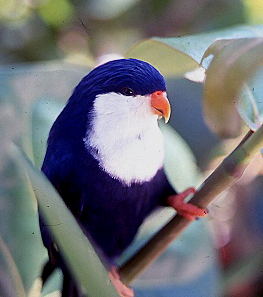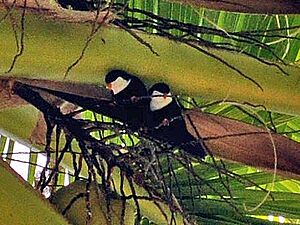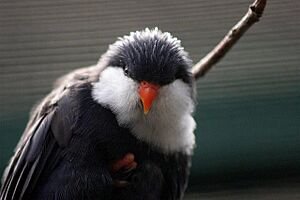Blue lorikeet facts for kids
Quick facts for kids Blue lorikeet |
|
|---|---|
 |
|
| Tuamotu, French Polynesia | |
| Conservation status | |
| Scientific classification | |
| Genus: |
Vini
|
| Species: |
peruviana
|
The blue lorikeet (Vini peruviana) is a small, colorful parrot found in the beautiful islands of French Polynesia and the Cook Islands. People also call it the Tahiti lorikeet or blue lory. This bird is mostly dark blue with a bright white patch on its chest, throat, and face.
Blue lorikeets are very active birds. They love to eat nectar from flowers, small insects, and other food they find on the ground.
Contents
Where Blue Lorikeets Live
The blue lorikeet originally lived only on the islands of French Polynesia. It is a special bird that belongs to these islands.
You can also find them in the Cook Islands, especially on Aitutaki. Scientists believe these birds might have been brought to the Cook Islands by people a long time ago. This is because old bones of other Vini lorikeets have been found there, but not the blue lorikeet.
Blue lorikeets can live in many different wooded areas. This includes places where people grow plants. They are often found where coconut trees and Heliotropium foertherianum plants grow together.
What Blue Lorikeets Look Like
The blue lorikeet is about 18 centimeters (7 inches) long. It has a short, rounded tail. Its feathers are mostly dark blue. It has a white area on its upper chest, throat, and lower face.
Feathers on top of its head can stand up. These show light blue stripes. Its beak is orange, and its eyes are yellow-brown. It also has orange legs. Male and female blue lorikeets look exactly the same.
Young blue lorikeets look a bit different. They do not have the white feathers of the adults. Their face and lower body are dark grey-blue. Young birds also have a black beak, dark brown eyes, and orange-brown legs. Having blue feathers is very rare for parrots. Only a few, like the related ultramarine lorikeet, share this color.
How Blue Lorikeets Behave
These birds sleep in coconut palm trees. They wake up at sunrise, calling and cleaning their feathers. Then they start looking for food.
Blue lorikeets usually fly in small groups. These groups have fewer than ten birds. They rest during the hottest part of the day in the shade. They start feeding again in the afternoon. As evening comes, groups fly around, calling until it gets dark. Then they go back to sleep between the palm leaves.
What Blue Lorikeets Eat
Blue lorikeets mainly eat nectar and pollen from flowers. They get food from coconut palms and other plants like Guettarda speciosa and Pemphis acidula. They also eat from bay cedar, beach mulberry, and Scaevola plants.
On one island called Rangiroa, they mostly ate coconut flowers during a study. They feed quietly in small groups. They use their special brush-like tongue to lick up nectar and pollen. If flowers are not fully open, they use their beaks to open them. After eating from one tree, they fly to the next, calling as they go. They also eat insects found on leaves and the forest floor. Sometimes, they eat young leaf shoots and soft fruits.
Protecting Blue Lorikeets
The blue lorikeet is considered a vulnerable species. This means its numbers are decreasing. They are mainly in danger because of animals that are not native to their islands. These include cats, rats, and swamp harriers. Mosquitoes that carry bird diseases also threaten them.




